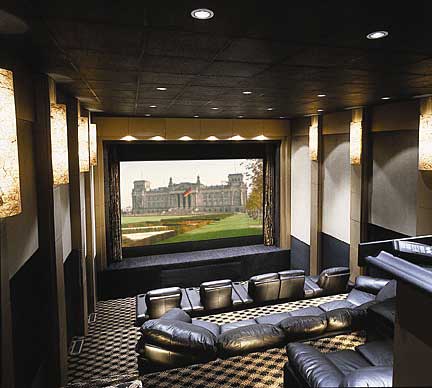Match Game: Specifying the Right Projection Screen for the Presentation Space
Selecting a Screen Surface
After the size of the projection screen has been determined, it is time to specify the surface of the screen. A successful projection is comprised of four separate elements: the projector, the projected material, the projection environment, and the projection screen. The projection requirements are determined by the projector, the projected material, and the projection environment. These requirements outline the situation in which the screen will need to perform. The viewing requirements describe the necessary performance specifications of the screen itself. The screen surface should be selected that best accommodates the projection requirements and meets the viewing requirements.
Projector Output
The power of any projector is measured in terms of the intensity of the light it produces. That light intensity is measured in lumens and, depending upon the lumens produced, projectors are classified as low output, moderate output, or high output projectors. All projectors have an output rating by the American National Standards Institute, which is commonly referred to as ANSI. Like horsepower on an engine, the higher the ANSI rating, the higher the light output from the projector. While there is no defined range for any of the output classifications, generally speaking, a projector measured between 700-1500 ANSI is considered low output. A moderate output projector attains a rating somewhere between 1500-3000 ANSI and any rating above 3000 ANSI would be considered a high output projector.
However, a higher output is not synonymous with a better image. The quality of the image produced also depends upon the size of the screen and the ambient light conditions paired with the projector. As an example, think of the light intensity from a projector like butter on a knife. The projection screen is a piece of bread. The light from the projector spreads out over the projection screen. The larger the screen, the thinner the layer of butter will be on the surface. In terms of projection images and light output, the larger the screen, the more spread out the light will be and the dimmer the image becomes. On the other hand, if the screen is too small to spread the light effectively, the image produced will be uncomfortably bright.
Material Projected
The material projected onto the screen in conference rooms, classrooms, auditoriums, and theaters typically falls into three categories: presentation material, video images, and polarized 3-D projection. Each category of material represents its own group of needs and
considerations when attempting to specify a screen that will maintain the integrity of the projected image.
Projectors do not produce the color black. Black is the absence of light and projectors produce light. Projection screens are not made in black. If they were, they would simply absorb the entire image projected at them instead of transmitting it or reflecting it back to the audience. This natural lack of black in projection technology reduces the contrast within the image on the screen, which can make the colors seem less vibrant. To improve the level of contrast on the screen, high-contrast fabrics are available. These high contrast fabrics are tinted gray. Adding gray to the screen tricks the human eye into seeing more contrast than was initially present. The grayscales appear darker, the whites brighter, and the colors more vibrant, which makes the image more impressive. These gray high-contrast screens are a good match for projecting video images, because the pictures are always moving, so the audience will not notice that the screen is gray.
|
These gray screens are not so inconspicuous when it comes to projecting presentation materials, like a spreadsheet or a word document that characteristically have white backgrounds. When the static image of a white spreadsheet is projected onto a gray screen, the image will look dirty and gray and it will sit there, dirty and gray, until the presenter moves to the next image, which hopefully was not built on a white background. When presentation material is the type of material that will be projected, it is best to specify a white screen. Never recommend high contrast material in a presentation type of application.
When projecting a polarized 3-D image, the projection screen will also need to be polarized to allow audiences to see the 3-D image. When specifying a polarized screen, it is important to know if the polarized images will be active, passive linear or passive circular. Then select the screen type designed to project that specific type of 3-D image.










